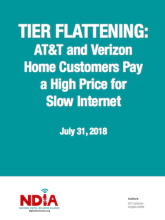
Fast, affordable Internet access for all.


In recent years AT&T and Verizon, the nation’s two largest telco Internet providers, have eliminated their cheaper rate tiers for low and mid-speed Internet access, except at the very slowest levels. Each company now charges essentially identical monthly prices – $63-$65 a month after first year discounts have ended – for home wireline broadband connections at almost any speed up to 100/100 Mbps fiber service.
This policy of upward “tier flattening” raises the cost of Internet access for urban and rural AT&T and Verizon customers who only have access to the oldest, slowest legacy infrastructure.
Affordability is the greatest barrier to increased home broadband subscriptions. In the United States, broadband is becoming faster for some households and more expensive for others.
This report from the National Digital Inclusion Alliance (NDIA) takes a detailed look at tier flattening from AT&T and Verizon, digging into monthly rates that users pay and the types of services they obtain from each company. The authors put the numbers side by side and show that those purchasing what used to be the most economical Internet access service are now simply paying higher rates for slow service.
Download the report to see the comparisons and the authors' analysis.

Early last year, Connect Your Community and the National Digital Inclusion Alliance released a well-researched and compelling case that AT&T had engaged in digital redlining of Cleveland, refusing to upgrade Internet access to neighborhoods with high poverty rates. In episode 290 of the Community Broadband Bits podcast, we check in to learn more and discuss key lessons.
Angela Siefer, executive director of NDIA, and Bill Callahan, President and Director of Connect Your Community in Cleveland, explore what is happening both in Cleveland and other metro centers where low-income residents are often over-paying for services far slower than are available in higher-income neighborhoods.
This discussion covers important ground, not just describing the problem but discussing how the easiest solution (forcing AT&T to upgrade areas it has neglected) is not sufficient. Also, there is sports talk at the beginning but then the host gets himself under control and focuses on what is important in this conversation.
This show is 35 minutes long and can be played on this page or via Apple Podcasts or the tool of your choice using this feed.
Transcript below.
We want your feedback and suggestions for the show-please e-mail us or leave a comment below.
Listen to other episodes here or view all episodes in our index. See other podcasts from the Institute for Local Self-Reliance here.
Thanks to Arne Huseby for the music. The song is Warm Duck Shuffle and is licensed under a Creative Commons Attribution (3.0) license.